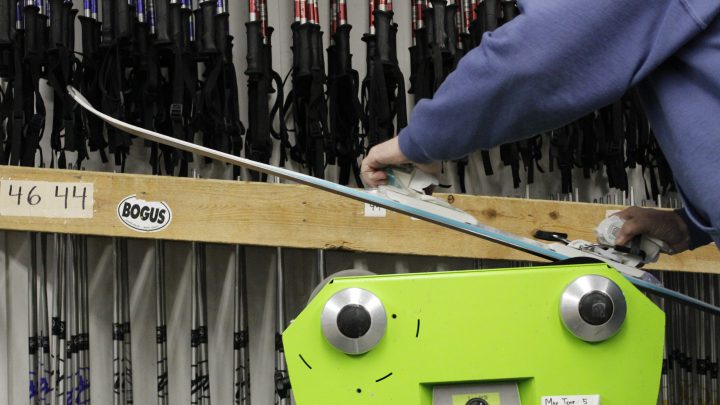
The ski wax industry is working to leave PFAS behind

On a slushy, warm day in February, Eric Straubhar buffed the wax on a child’s ski.
Straubhar manages the rental shop at Bogus Basin, a ski resort outside Boise, Idaho. He said it had been a few years since he first heard that PFAS was a problem in high-end ski waxes. From what he knew, these “fluorinated” or PFAS, additives had been in ski equipment in some form or another for decades.

“There were a myriad of powders and different things, and then waxes,” he said.
PFAS, an abbreviation for perfluoroalkyl and polyfluoroalkyl substances, is a class of chemicals often referred to as forever chemicals. They’re man-made, have circled the globe and don’t break down in the environment — or our bodies. They can cause cancer and other diseases and suppress immune systems, among other things.
These chemicals have been used in everything from Teflon and Gore-Tex to dental floss. But the ski wax industry is one of many trying to leave it behind.
That includes racing organizations banning the use of PFAS waxes in various races. That came after concerns arose about the health of people who make and use the waxes as well as worries about the environment.
Straubhar said he hasn’t heard much pushback against the bans. As long as the playing field is even, he said, that’s what matters most to competitors.
“If everyone is using similar waxes and you don’t have those fluorinated products out there … the playing field is level,” he said. “So I haven’t heard any complaints.”
PFAS wax does make skiers go faster than older alternatives, especially in cross-country races. But research shows the wax can contaminate the snow and ground.
Gail Carlson directs the Buck Lab for Climate and Environment at Colby College in Maine. Her son was a Nordic racer, and she was concerned about the waxes. So she tested the snow after a race in 2020.
“What we found was that the snow at the start line was extraordinarily contaminated with these fluorochemicals, which are called PFAS,” she said. “And the snow was so contaminated that the testing lab that did our work for us asked me, like, ‘What is this sample?’”
Research and international regulations have led to changes. That includes the International Ski Federation, U.S. Ski & Snowboard and Canadian snowsports associations banning many fluorinated waxes beginning with the 2021-22 season.
However, racing organizations haven’t banned the chemicals outright. PFAS rules can depend on whether a race takes place in the U.S., the types of PFAS wax used, who’s running the race and what kind of race it is.
“Cross-country has gone all in on a fluoro-free environment,” said Steven Poulin, managing director of Brav USA.
Brav owns ski wax leaders Swix and Toko. As Poulin explained it, while waxing rules are complicated right now, the future of wax is PFAS-free. His company no longer makes waxes with PFAS, thanks to millions of dollars invested in researching alternatives starting in 2009.
“We knew there was different chemistry out there that was just better for the environment,” he said. “So we had an internal project … which has led us to a fluoro-free company.”
The Environmental Protection Agency fined Swix about $375,000 in 2020, after that company imported ski wax products containing PFAS chemicals that violated the Toxic Substances Control Act. A settlement between the EPA and Swix resulted in a $1 million public education campaign called the Responsible Waxing Project.
“I think we’re going to all be able to look back and go, ‘Wow, that’s how it’s supposed to work. That’s really how it’s supposed to work,’” Poulin said.
This year, the EPA put out an alert saying that several other high-performance ski waxes being sold violate the TSCA. The agency is “concerned that recently identified TSCA violations may be putting skiers and wax applicators at risk for exposure to certain persistent and bioaccumulative chemicals.”
If PFAS waxes are banned worldwide, there are scanners of a sort to detect them in the field. But they don’t work perfectly, and not everybody has one. Still, bans alone could work.
Just a year after Carlson published her work on PFAS in snow, Maine passed a law directing industries to move away from all kinds of unnecessary PFAS uses by 2030, including ski wax. Carlson recently returned to the Nordic track she tested a few years ago, where PFAS waxes are now banned.
“And another research student and I went out and gathered snow again at the start line right after the race, and there was hundreds of times less PFAS contamination in the snow. It wasn’t zero, but it was, you know, very, very low compared to what we found two years ago,” she said.
Ultimately, those in the ski wax industry say their successes show that other industries can make the move away from PFAS too. But that will likely take millions of dollars in research and more efforts to find effective alternatives.
There’s a lot happening in the world. Through it all, Marketplace is here for you.
You rely on Marketplace to break down the world’s events and tell you how it affects you in a fact-based, approachable way. We rely on your financial support to keep making that possible.
Your donation today powers the independent journalism that you rely on. For just $5/month, you can help sustain Marketplace so we can keep reporting on the things that matter to you.

















